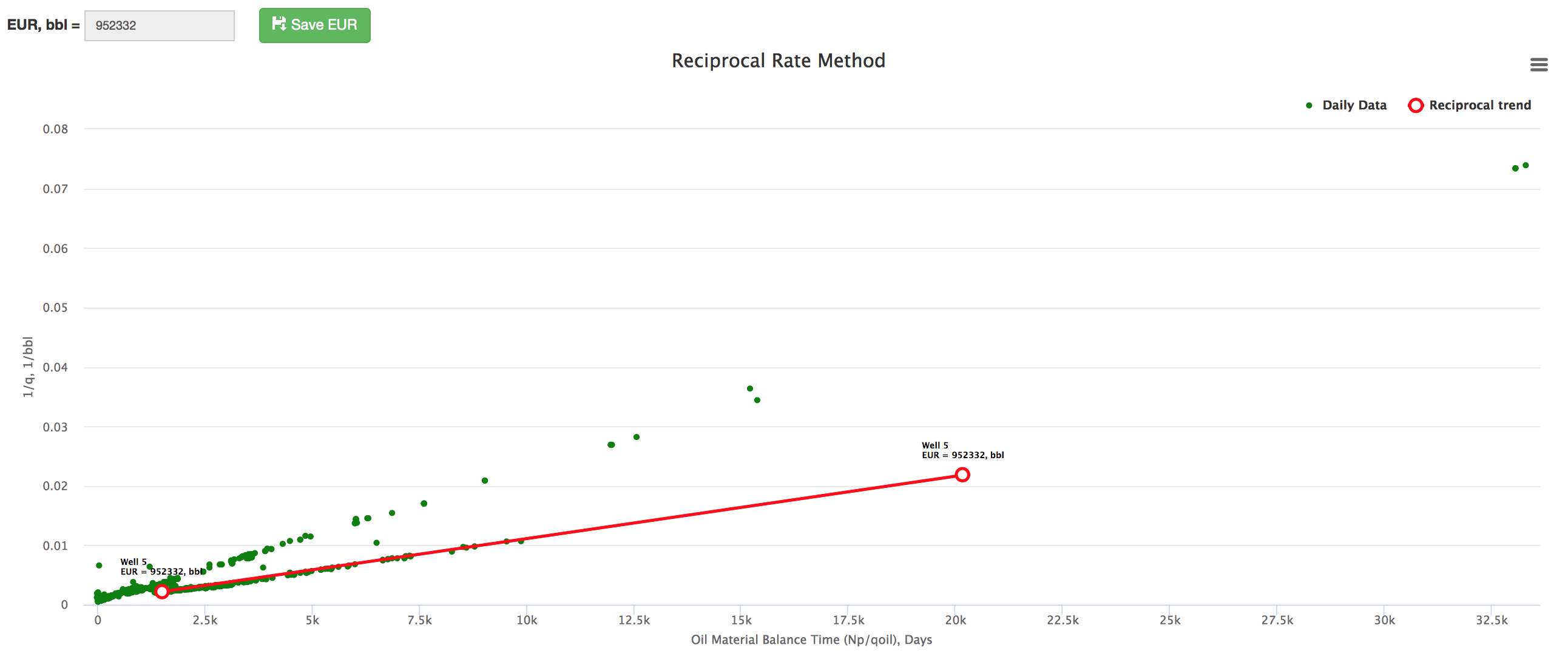Difference between revisions of "Reciprocal Rate Method"
(→Math & Physics) |
(→Math & Physics) |
||
| Line 20: | Line 20: | ||
:<math> P_i - \bar{P} = m_{mb} N_p</math>, is pressure drop due to depletion defined by the [[Oil Material Balance]] for black oil at P>P<sub>b</sub>, | :<math> P_i - \bar{P} = m_{mb} N_p</math>, is pressure drop due to depletion defined by the [[Oil Material Balance]] for black oil at P>P<sub>b</sub>, | ||
| − | :<math> \bar{P}-P_{wf} </math>, is pressure drop due to [[Darcy's law]] | + | :<math> \bar{P}-P_{wf} = 141.2 q_o /mu_o B_o</math>, is pressure drop due to [[Darcy's law]] |
==Discussion== | ==Discussion== | ||
Revision as of 20:19, 28 May 2018
Contents
Brief
Reciprocal Rate Method - is the method to estimate oil Wells and Reservoirs EUR using only rate-time production data[1] published in 2007 by Thomas Blasingame et al.
The methodology does presume that flowing well bottomhole pressures are approximately constant[1].
The interpretation technique is fitting the data points with the straight line to estimate the slope which gives EUR.
Math & Physics
The total pressure drop at the wellbore is:
Where
 , is pressure drop due to depletion defined by the Oil Material Balance for black oil at P>Pb,
, is pressure drop due to depletion defined by the Oil Material Balance for black oil at P>Pb,
 , is pressure drop due to Darcy's law
, is pressure drop due to Darcy's law
Discussion
Reciprocal Rate Method can be applied to estimate:
Case Study
This Case Study demonstrates the application of the Oil Flowing Material Balance engineering technique using the E&P Portal.
The Study is based on the oil well from a field in West Siberia, Russia.
It is shown how to:
- Input the data to the E&P Portal;
- Apply the Oil FMB to estimate the well's STOIIP and JD;
- Save and export the analysis results.
All the input data is attached to the Case Study for the reference.
Download the input well production data (csv)
Workflow
- Upload the data required
- Open the Oil Flowing Material Balance tool here
- Estimate the N (red line X-axis intercept)
- Calculate the average reservoir pressure
 based on N, known production data and using Oil Material Balance equation
based on N, known production data and using Oil Material Balance equation - Calculate the

- Calculate the

- Plot the orange
 vs
vs  line:
line: - Change the N to match the orange line with the red one
- Change the gray JD line Y-axis intercept to match the changing JD
- Save the Oil Flowing Material Balance model
- Move to the next well
Data required
- Create Field here
- Create or Upload Reservoirs here
- Input the Reservoirs GIIP and STOIIP here
- Create or Upload PVT (SG, Pi, Ti) here
- Upload Wells
- Create or Upload Wells Perforations here
- Create or Upload kh and JD here
- Upload Daily Measures
In case you need to calculate the flowing bottomhole pressure from the wellhead pressure:
- Calculate the flowing bottomhole pressures using BHP Calculator
- Export flowing bottomhole pressures to Daily Measures here
In case you want to add the static reservoir pressures on the FMB Plot:
- Create or Upload the static reservoir pressures, here
- Calculate Monthly Measures from the Daily Measures using Monthly Data Calculator
Nomenclature
References
- ↑ 1.0 1.1 Blasingame, Thomas Alwin; Ilk, Dilhan; Reese, Parker D. (2007). "Estimation of Reserves Using the Reciprocal Rate Method"
 (SPE-107981-MS). Society of Petroleum Engineers.
(SPE-107981-MS). Society of Petroleum Engineers.



